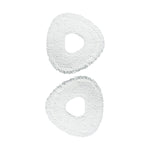Robot vacuum technology has evolved rapidly, but how exactly do these smart devices work, and what features should you look for when choosing one? Whether you're curious about the advanced sensors, LiDAR navigation, or AI-driven controls behind these machines, this guide will walk you through the key components that power today’s top-performing robot vacuums.
We'll explore how they navigate and map your home, what battery systems and charging tech they use, and how smart features like app control and voice integration enhance convenience. You’ll also learn what to consider when choosing a robot vacuum for Australian homes, where large floor plans, pets, and mixed flooring are common.
By the end, you'll understand not just how robot vacuums clean — but which technologies matter most for your lifestyle.
How Do Robot Vacuums Navigate and Map Your Home?

Robot vacuums rely on sophisticated mapping and obstacle detection systems to clean efficiently — especially important for homes with lots of furniture, kids, or open-plan layouts, which are common in Australia. Let’s break down the different types of navigation systems used today.
LiDAR Technology
LiDAR (Light Detection and Ranging) is at the forefront of robot vacuum navigation technology. It works by emitting laser beams that bounce off surrounding objects and return to the sensor. By calculating the time it takes for the laser to return, the vacuum creates a detailed and accurate map of the room.
This level of precision is especially useful in larger Australian homes, which often feature open-plan living areas or multiple connected rooms. LiDAR enables the vacuum to navigate complex spaces without missing areas or repeatedly cleaning the same zone.
Example: The Narwal Freo X Ultra features LiDAR 4.0 Navigation, scanning your home in 360 degrees to determine the most efficient cleaning route — ensuring every space is covered, even in challenging layouts.
Camera-Based Navigation
Camera-based navigation uses onboard cameras to visually capture the environment. These images are processed in real-time to help the robot recognize its position and plan cleaning routes.
This system allows for adaptive mapping — adjusting as furniture moves or new objects appear. However, camera-based navigation may be less reliable in low-light conditions, which is worth considering if you plan to schedule nighttime cleaning runs.
Sensor-Based Navigation
Basic robot vacuum models typically rely on a range of sensors to navigate:
-
Infrared Sensors detect obstacles by emitting light and measuring reflections, helping the vacuum avoid bumps.
-
Ultrasonic Sensors use sound waves to calculate distance and steer around objects.
-
Cliff Sensors prevent falls from stairs or ledges, particularly useful in multi-level homes.
While these sensors provide fundamental guidance, they often lack the precision of LiDAR or visual systems and may result in more random cleaning paths. For open and uncluttered floor plans — common in many Aussie homes — upgrading to more advanced navigation ensures more efficient coverage.
[cta:narwal-freo-x-ultra-robot-vacuum-mop]
What Are the Battery and Charging Technologies?

For robot vacuums to clean efficiently, especially in spacious Australian homes with multiple rooms or open-plan layouts, battery performance and smart charging capabilities are critical. Let’s take a closer look at the key technologies that keep these devices powered and ready to clean.
Battery Types and Capacities
Most modern robot vacuums use Lithium-ion (Li-ion) batteries, known for their higher energy density, longer lifespan, and lighter weight compared to older Nickel-metal hydride (NiMH) options. This means they can clean longer without needing a recharge — an essential feature for larger homes.
While NiMH batteries are still used in some budget-friendly models, they tend to be heavier, have shorter runtimes, and require more frequent recharging.
Narwal’s Freo X Plus, for example, is equipped with a high-efficiency Li-ion battery that delivers up to 254 minutes of runtime — more than enough to cover multiple rooms or even an entire home in one charge.
Smart Charging and Auto-Docking
Smart charging systems improve usability by reducing manual intervention. There are two key features to consider:
-
Auto-Docking: When the battery runs low, the robot automatically returns to its docking station. Once recharged, many models can resume cleaning from where they left off — perfect for households that need regular, uninterrupted maintenance.
-
Quick Charging: Some high-end models also support fast charging, minimizing downtime between cleaning sessions.
Narwal vacuums include intelligent charging management, optimizing both energy use and cleaning efficiency. For homes with pets or kids — where messes can build up fast — this ensures the vacuum is always ready to go when needed.
What Are the Smart Features and Connectivity Options?
Smart features are what truly differentiate modern robot vacuums from traditional cleaning devices. For many Australian households — especially those balancing work, kids, and pets — these smart systems offer not just convenience, but real lifestyle upgrades.
Let’s explore how features like app control, voice commands, and AI technologies make robot vacuums more efficient and hands-free.
Wi-Fi and App Control

Through Wi-Fi connectivity and companion apps, robot vacuums can be scheduled, controlled remotely, and monitored — all from your smartphone.
For busy Australians, this means you can set the vacuum to clean after you've left for work, or while running errands, without needing to be at home.
Key benefits include:
-
Flexible Scheduling: Choose preferred cleaning times, such as late mornings when the house is empty.
-
Remote Access: Start or pause cleaning from your phone, even if you're out walking the dog or picking up the kids.
-
Live Status Tracking: Monitor cleaning progress, battery levels, and room coverage in real time.
The Narwal app allows you to customize cleaning zones, create room-specific routines, and receive maintenance reminders — all from a clean and easy-to-use interface.
Voice Control Integration

Robot vacuums with voice control can integrate seamlessly with smart home systems like Amazon Alexa, Google Assistant, and Apple Siri — all commonly used in Australian households.
Instead of reaching for your phone, simply say:
-
“Alexa, start vacuuming the living room.”
-
“Hey Siri, stop cleaning.”
-
“OK Google, send the vacuum back to base.”
This feature is especially helpful for multitasking — like when you're cooking, feeding kids, or lounging on the couch with your feet up.
Artificial Intelligence and Machine Learning
Advanced AI and machine learning enable your robot vacuum to become smarter over time, adapting to your routines and home layout.
Real-world benefits include:
-
Learning your space: The vacuum maps your home more efficiently with every run, reducing missed spots or duplicate passes.
-
Obstacle recognition: Over time, it gets better at avoiding pet bowls, toys, cords, and even socks on the floor — which helps reduce interruptions.
-
Cleaning optimization: The system can adjust suction or mopping intensity based on the floor type and dirt levels, offering more personalized cleaning without user input.
For example, the Narwal Freo X Ultra leverages AI to create ultra-efficient cleaning paths, detect frequently dirty zones, and avoid problem areas automatically — no need to set boundaries every time.

From remote control and voice commands to self-emptying and advanced cleaning features, modern robot vacuums are designed to make home cleaning effortless and efficient. Products like the Narwal Freo X Ultra and Freo Z Ultra showcase these smart functionalities, offering users a truly intelligent and hassle-free cleaning experience. As technology continues to evolve, robot vacuums will become even more integrated into our daily lives, redefining the way we maintain our homes.
How to Choose a Smart Robot Vacuum in Australia
With so many features and models on the market, choosing the right robot vacuum can feel overwhelming. For Australian homes, specific lifestyle and layout factors — like open-plan designs, mixed flooring, and pet ownership — make smart vacuum selection even more critical.
Here are key factors to consider when making your choice:
1. Home Size and Layout
If you live in a larger single-storey or multi-room house (common across Australian suburbs), opt for a model with:
-
Long battery life (200+ minutes)
-
LiDAR-based mapping for accurate navigation
-
Auto recharge and resume, so it can finish cleaning even if it takes multiple sessions
For example, Narwal Freo X Plus runs up to 254 minutes and resumes cleaning automatically.
2. Flooring Types
Many Australian homes feature a mix of tile, hardwood, laminate, and carpet. Look for vacuums that:
-
Detect floor type automatically and adjust suction or mop settings
-
Lift the mop when crossing carpet
-
Offer dual brushes or rotating mops for hard floor scrubbing
Narwal's AI DirtSense™ technology adjusts cleaning mode based on surface and mess level.
3. Pets and Allergies
If you have pets or allergy sufferers at home:
-
Choose models with HEPA filters to trap fine dust and allergens
-
Strong suction (10,000+ Pa) helps handle pet hair
-
Obstacle avoidance reduces the risk of getting stuck on toys or pet bowls
Narwal vacuums include HEPA filtration and dual AI cameras to avoid common household clutter.
4. Smart Features and Control
Consider how hands-free you want the experience to be:
-
App control for scheduling while you're out
-
Voice assistant compatibility (Google Assistant, Alexa, Siri)
-
Customizable room-by-room cleaning for busy or high-traffic zones
5. Maintenance and Upkeep
Look for self-cleaning features if you want minimal manual work:
-
Auto mop pad rinsing and drying
-
Large dustbins or auto-empty stations
-
Filter cleaning and maintenance reminders via app
Narwal’s base station washes and dries mop pads automatically, reducing the time you spend on maintenance.
Conclusion
Robot vacuums are no longer just futuristic gadgets — they’re smart, efficient cleaning partners designed to make daily life easier. With technologies like LiDAR mapping, AI-driven obstacle avoidance, and intelligent app control, these devices adapt to your home and habits, taking the hassle out of floor cleaning.
For Australian households, where large floor plans, pet ownership, and active family life are common, choosing a robot vacuum with strong navigation and smart automation is especially important. Whether you're looking for hands-free daily cleaning or advanced features like room mapping and dirt detection, understanding the tech behind these machines helps you make a better choice.
Narwal's Freo series, for example, blends high-end features like extended battery life, advanced mapping, and minimal user maintenance — ideal for modern homes that demand both performance and simplicity.
What AI technologies does a robot vacuum use?
Most robot vacuums today use machine learning to improve over time and computer vision to detect and avoid obstacles. Advanced models can adjust routes, remember frequent dirt spots, and even optimize performance based on your home layout.
How does a robot vacuum know where to clean?
By combining technologies like LiDAR, cameras, and infrared or ultrasonic sensors, robot vacuums create detailed maps of your home. They use this data to plan the most efficient cleaning paths — covering every room without missing or repeating areas.
How does a robot vacuum find its base?
When cleaning is done or the battery runs low, the vacuum returns to its charging dock using infrared or radio signals emitted by the base. Some models — like those from Narwal — also use stored home maps to find the fastest way back to the base station.
Is a robot vacuum suitable for larger Australian homes?
Yes — especially models with long battery life (over 200 minutes), LiDAR navigation, and smart recharge-and-resume functions. These features ensure consistent cleaning even across large open spaces or multiple rooms.
Do robot vacuums work well with pets and kids around?
Definitely. Look for models with HEPA filtration (to capture allergens), obstacle avoidance (to avoid toys or bowls), and app control so you can schedule cleaning when no one’s around — like after the morning school drop-off or before dinner prep.









































